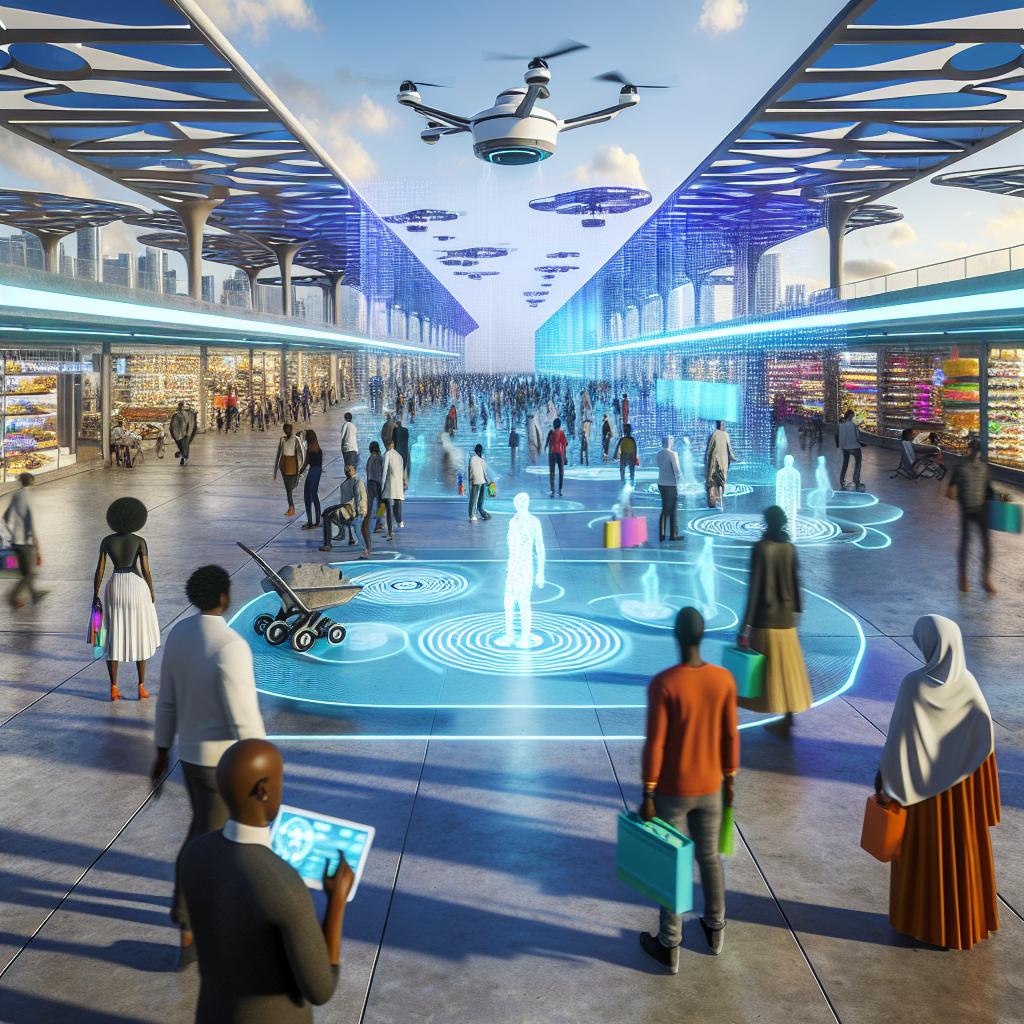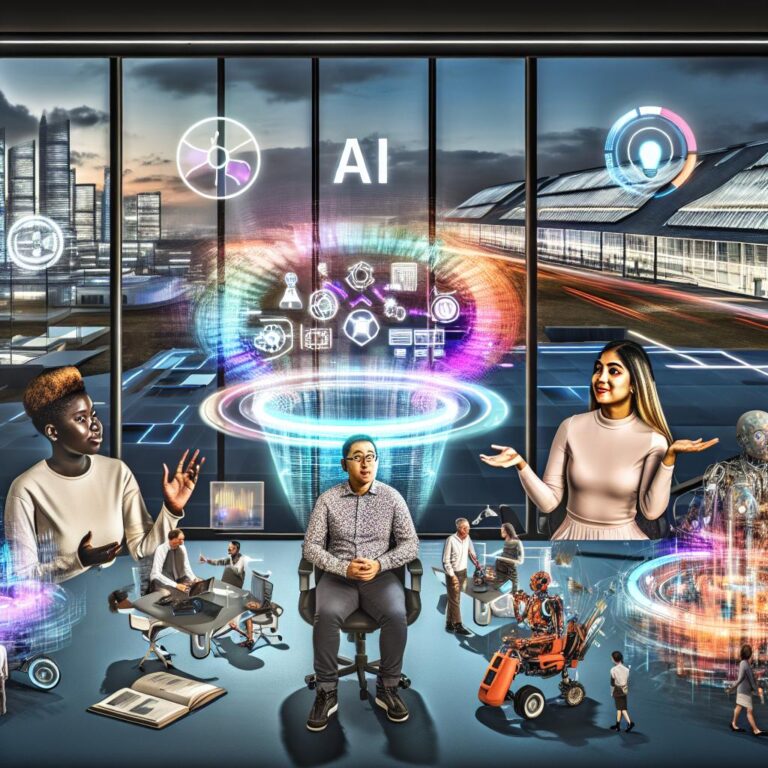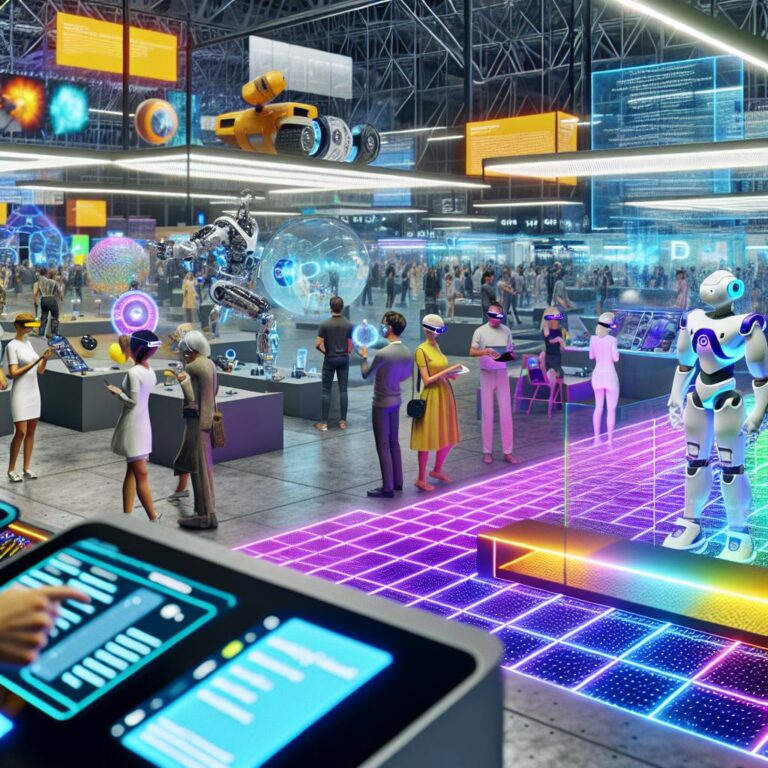Future of ecommerce: What trends shape its next phase?

AI, AR, blockchain, and sustainability are revolutionizing e-commerce.
- AI increases personalization, enhances inventory management, and refines marketing through predictive analytics and personalized ads.
- AR allows virtual product trials, improving decision-making and reducing returns.
- Blockchain enhances security and efficiency in transactions and supply chains, aiding in fraud prevention and loyalty programs.
- E-commerce is becoming more sustainable, emphasizing eco-friendly practices and secondhand marketplaces, driven by consumer demand for transparency and sustainability.
- Retail trends show a rise in frictionless payments like Buy Now Pay Later (BNPL) and the growth of retail media networks.
- By 2025, seamless and personalized shopping will dominate, with AI and sustainability central to strategies.
- E-commerce business models must adapt to technological advancements and changing consumer behaviors for future success.
The future of ecommerce is more exciting than ever. It's where AI, augmented reality, and blockchain meet, influencing how we buy and sell. As tech fans, we crave to know how these innovations change our digital shopping experiences. What does the future hold for ecommerce after COVID-19? How will consumer habits shift by 2025? Let's dive deep into these trends and discover what shapes the next phase of ecommerce.
How is AI revolutionizing ecommerce?

AI is changing ecommerce in many exciting ways. One big change is how AI makes shopping online more personal. Imagine you walk into a store. The shopkeeper knows your style and taste and shows you things you might like. This is what AI does on ecommerce sites. AI-driven personalization uses machine learning to study what you like. Then, it suggests products that could interest you. This means less time searching and more time finding what you love.
Now, you might wonder how AI personalization works. The magic happens with data. AI collects data about your past purchases and your browsing habits. Using algorithms, it predicts what you might buy next. This increases Precision as it recommends more accurate choices. When you see suggestions that match your style, your shopping feels more tailored.
Another exciting AI area is inventory management. AI helps keep track of items in stock, even better than people. It predicts the amount you will need for each product. Precise prediction reduces wasted stock and saves money. This is called predictive analytics. AI tools analyze sales patterns and trends to ensure stores never run out of popular items. This means annoying “out-of-stock” signs could become less common.
AI also spices up the shopping experience with generative AI, like zero-click search. You might think, "What is zero-click search?" It means finding what you want without typing. This is a game-changer in ecommerce. Google's Search Generative Experience is an example. You speak to search engines, and they understand what you need. Then they show you the best deals right away. It's like a smart assistant doing the shopping for you.
How does AI impact ecommerce platforms broadly? It also supports seamless shopping and payment. AI-enhanced payment options, like Buy Now Pay Later (BNPL), become simple and smooth. Many shoppers, especially Millennials and Gen X, love BNPL. AI tracks expenses, helping users buy what they need without hurting their budgets. But, there's a caution: keep spending in check to avoid debt.
Next, let's discuss AI in marketing. Retail media networks are using AI for personalized ads. These networks are booming, expected to make 15.4% of ad revenue by 2028. Personalized ads use AI to show items you might actually want to buy. This makes advertising very effective and less annoying for shoppers. AI tools analyze customer data to target ads more precisely. This increases the chances you'll click on them.
In our push for a greener world, AI assists in authenticity checks for secondhand marketplaces. With living costs high, more people buy secondhand goods. AI checks item condition automatically, ensuring they're real and in good shape. AI's Precision in identifying wear and tear helps retailers save on costs while offering reliable products.
Have you wondered about smart supply chains? AI assists there too. It keeps the supply chain lean and transparent. This means less waste and more trust in sourcing. When brands show how they source products, consumers feel confident buying from them. AI helps monitor every step, ensuring quality and keeping waste low.
Finally, AI aids in using user-generated content. We've seen how people trust word-of-mouth. About 30% of shoppers talk about products with friends. Retailers now use AI to gather and use customer reviews and pictures. This builds trust and attracts younger buyers who enjoy authentic stories.
In conclusion, AI is revolutionizing ecommerce through personalization, inventory management, and smart marketing. Each section of ecommerce reaps the rewards of AI technology. As retailers integrate AI, shopping online becomes smarter, faster, and just more fun.
What role does augmented reality play in online shopping?
Augmented reality, or AR, is changing how we shop online. Many of us have experienced the struggle of buying clothes or furniture without knowing if they will fit or match our style. AR solves this. It lets us see how products will look in our own homes or on our bodies before buying them. Imagine trying on clothes without going to a store or seeing a new couch in your living room before purchasing it. AR makes all of this possible and is reshaping online shopping today.
How is AR transforming the way consumers shop online?
AR is giving us a new way to see and experience products. It makes online shopping more engaging and realistic. With AR, shoppers can interact with products as if they are physically there. This creates a more confident buying decision and reduces the chances of returns. For instance, when you want to buy makeup, AR tools can show how different shades look on your skin in real-time. This is called a virtual try-on. It not only saves time but also enhances our shopping experience by offering personalized choices.
Retailers are rushing to adopt AR technology because it boosts customer satisfaction and engagement. This tech creates a sense of control and personalization. It helps us see what fits our needs best, making shopping easier and more fun. Big companies are now investing heavily in AR to stay ahead of the competition.
What are future trends in augmented reality for retail?
The future of AR in e-commerce looks bright and exciting. We can expect AR to go beyond just trying on clothes or makeup. In the future, AR could allow us to create custom products by visualizing different features before making a decision. For example, think about designing a pair of sneakers — choosing colors, patterns, and designs — and seeing the final product through AR before purchasing.
As technology advances, AR will get even better, offering smoother and more realistic interactions. Touch and gesture controls could soon become part of the AR experience. Shopping platforms might also start using AI alongside AR to suggest more personalized products based on our preferences, making our shopping more efficient and delightful.
We are seeing the integration of AR in more shopping apps and websites, even amid economic challenges. Companies are bundling AR with other smart technologies like generative AI and digital payment solutions to create seamless experiences. This move is also bolstered by changes in consumer preferences. Many now wonder how AR will influence their shopping habits, and the answer is through enhanced interaction and personalization.
The AR trend is not just limited to big global retailers. Small and medium businesses are also adopting this technology, allowing them to offer upscale retail experiences without a large budget. They see an opportunity to attract more customers by offering personalized shopping experiences, an area where AR shines.
AR is here to stay, and as it advances, it will reshape how we interact with retailers. From virtual stores to fully interactive shopping environments, our e-commerce landscape is set for a thrilling transformation. Brands that embrace AR will lead this retail revolution, offering engaging and tailored experiences.
Why is blockchain becoming important in ecommerce payments?

Blockchain technology is set to redefine the landscape of e-commerce payments. How does blockchain ensure secure transactions in ecommerce? The Stanford Question Answering Dataset method would prioritize the answer with absolute clarity: Blockchain's structure, where data is stored in blocks linked using cryptography, provides security. It ensures that transactions are verified, timestamped, and encrypted. Each transaction must be validated by multiple participants, creating a trustworthy environment.
In e-commerce, trust between buyers and sellers is crucial. With blockchain, trust is inherent. Once a transaction is verified, it is nearly impossible to change. This significantly reduces the risk of fraud and guarantees that data and transaction history are tamper-proof. Furthermore, blockchain can streamline the transaction process. Its transparency and efficiency can cut out many of the intermediaries usually involved, thus cutting costs and speeding up transactions.
Let's address the potential blockchain holds for future ecommerce payment solutions. The future could include smart contracts: automated, self-executing agreements with clear, pre-set parameters. Imagine buying a product online, and a smart contract ensures the payment only happens once the product ships. This reduces disputes and builds trust without needing a middle person.
Blockchain could also solve the problem of chargebacks and refund fraud. Today, these issues cost retailers billions annually. With blockchain, chargebacks could reduce without compromising customer protection because transactions are transparent and linked to smart contracts.
There’s more: blockchain presents a secure means for managing loyalty programs. Digital tokens representing points can be tracked on the blockchain, creating a fair system. This could lead to new customer engagement strategies using blockchain to transform points into currency, usable anywhere within the brand’s ecosystem.
In the grand landscape of payments, cryptocurrencies are often part of the conversation. More retailers are beginning to accept Bitcoin and other cryptocurrencies. They offer clients a new form of payment and align brands with customers who prefer digital wallets. Blockchain transactions, involving cryptocurrencies, are recorded with precision and provide a highly secure process. This aspect of blockchain technology could become integral to e-commerce payments.
E-commerce growth relies heavily on seamless experiences. In 2024, the push will focus on personalizing shopping even amid economic constraints like high consumer debt. Customers want fast, easy experiences like the ones provided by blockchain technology. Using blockchain for payments fits seamlessly into this trend.
Retailers need to invest in technology that enhances efficiency and builds trust with their customers. Blockchain can certainly help achieve these goals. It can facilitate zero-click shopping experiences powered by generative AI. This technology allows customers to spend with minimal effort securely.
Let's not forget that any innovation, even blockchain, comes with its challenges. Adopting it requires investments and changes at the core processing level. Also, while blockchain offers transparency, this transparency needs to balance with data privacy concerns. Brands must manage how much information becomes public in this process.
Blockchain’s potential lies in how well it integrates with other technological advances. A future e-commerce landscape with smart supply chains could benefit from blockchains’ traceability to reduce waste. As consumers become more environmentally conscious, they will demand transparency about product origins and sustainability. Blockchain can lend credibility to these sustainable claims through immutable ledgers.
In shaping the future, blockchain emerges as a beacon of innovation in ecommerce. It is not just a buzzword but a promising force adding security, transparency, and efficiency. If retail adopts blockchain effectively, it aligns with customer trust and tech advancements. This alignment ensures that businesses stay ahead in the competitive e-commerce sector.
How is consumer behavior expected to change by 2025?

Consumer behavior is rapidly changing, and by 2025, the way people shop online will be unrecognizable. Let's dive into some key trends.
First off, there is an increasing demand for seamless, hyper-personalized experiences. In 2024, retailers have started to push this. Shoppers expect their online carts to feel tailor-made. They want websites to remember their preferences. Retailers are investing in artificial intelligence to enable these experiences. AI tools can suggest products you might love before you know you love them. For instance, generative AI, like Google's Search Generative Experience, is revolutionizing shopping. It allows you to find deals and products in real-time. Such technology is thrilling nearly 27% of consumers.
Retail media networks (RMNs) represent another trend. You might not even realize when you're seeing an RMN ad. But these ads are everywhere. They're growing fast, and people are surprisingly okay with targeted advertising now. By 2028, RMNs might scoop 15.4% of ad revenue. If you see an ad that feels just right for you, it's because AI and personalized ad strategies have grown.
Next, let's talk about sustainability. Economic challenges and ethical choices are driving consumer behavior. Many shoppers now choose secondhand goods. It's not just a trend; it's a movement. Due to rising living costs, around 44% of UK consumers prefer this option. AI is making secondhand shopping more effortless. It authenticates the quality of items, ensuring buyers get what they pay for. Consumers are also drawn to "slow living." They desire sustainable and high-quality products. But while they favor durable goods, they worry about their cost.
The payment landscape is changing too. Frictionless options like Buy Now Pay Later (BNPL) are becoming vital. Half of Gen X and millennials have used short-term payment options. These methods enable immediate purchases without a credit card. However, some worry about rising personal debt. Retailers need solutions that balance ease and responsibility.
Let's zoom in on AI's role in marketing. You've probably noticed more engaging ads recently. AI-generated visuals make shopping enticing. They personalize how products are displayed online, leading to higher conversions. Yet, there is some concern. Can too much AI lead to job loss or spread misinformation? These are valid fears and deserve attention.
Authenticity in online shopping remains critical. Did you know that 30% of global consumers rely on word-of-mouth for brands? Retailers that leverage user-generated content, like reviews and photos, attract younger shoppers. It's a modern twist on trusting a friend's recommendation.
Lastly, future shopping will see smarter supply chains. Using digital tools, businesses can reduce product waste. They ensure goods are ethically sourced and transparently provided. This trust can boost consumer confidence and bring investors on board.
In closing, future e-commerce will demand adaptability. Retailers must embrace new tech and strategies. The key to success is meeting changing consumer needs head-on. Retailers should aim for innovation while keeping focus on meeting consumer needs. New tech, trends, and customer strategy alignment are essential. Prepare for a dynamic, evolving e-commerce future.
What is the future of ecommerce after the COVID-19 pandemic?

The world of ecommerce has changed a lot since the COVID-19 pandemic. One of the most noticeable changes is how consumer purchasing behavior has shifted. Many customers now expect seamless and hyper-personalized shopping experiences. Retailers are investing in digital business transformation to meet these new demands. Artificial intelligence is helping businesses create improved customer experiences.
Real-time deal comparisons are becoming more popular because of generative AI. This involves using zero-click search technology, like Google's Search Generative Experience. Customers find what they need faster, which makes shopping easier. About 27% of consumers are excited about these new technologies. But, with excitement also comes challenges like misinformation and the impact on jobs.
Retail media networks (RMNs) are also seeing growth. By 2028, they could cover 15.4% of ad revenue. Consumers don't mind personalized ads as much as they used to. These networks provide tailored advertisements that align with individual preferences. This trend is bringing in revenues faster than search and social media.
Budget constraints push people to look at secondhand marketplaces. The rise in living costs and sustainability concerns make buying pre-owned items more appealing. In the UK, about 44% of consumers now buy secondhand more than before. Tools powered by AI help check the authenticity of these items, which saves costs for retailers.
The "slow living" trend is another development. People want sustainable products that last longer. Even though living costs are high, there's still a drive for high-quality goods. This mindset goes against overconsumption. Consumers are now more focused on durable products.
In terms of payments, options like Buy Now Pay Later (BNPL) have gained popularity. Half of millennials and Gen X have used short-term financing recently. While convenient, these solutions can increase consumer debt if not managed carefully.
Retailers must create authentic shopping experiences. Shoppers often recommend brands via word-of-mouth if they find them trustworthy. User-generated content attracts younger buyers, fostering a sense of community and authenticity.
Lastly, the rise of smart supply chains promises less product waste and more transparency. Digital technology aids in tracking product sources, which boosts trust among buyers and investors. By adopting new technologies and adapting to trends, retailers can achieve future success. These efforts must meet customer needs while enhancing existing strategies.
The ecommerce landscape post-COVID is full of challenges and opportunities. The future of ecommerce will rely on understanding these changes and leveraging them effectively. Retailers must be proactive in embracing tech advances to thrive in this new era.
How are ecommerce business models evolving?

Ecommerce is changing fast. New trends are reshaping how businesses work online. The push towards seamless and hyper-personalized shopping is strong. But what are the emerging ecommerce business opportunities? Let me dive into that.
Precision Answer: Businesses are exploring AI advancements and retail media networks (RMNs).
Now, why focus on AI and RMNs? AI provides real-time, personalized deals and searches. Imagine walking into a store that knows your needs and offers choices just right for you. In 2024, 27% of consumers are excited about these advancements. These AI features drive faster comparisons and elevate your shopping ease.
Retail media networks are another key player. They earn big and grow faster than search or social networks. By 2028, RMNs could hold 15.4% of ad revenue. These networks use data to target ads better. Many consumers now accept these ads. They see them as helpful, not bothersome. This shift is crucial for new business spots.
Adaptive Ecommerce Platforms
Let’s explore how ecommerce platforms are adapting to new market demands. The landscape around us is changing because of the economy and technology all at once.
Precision Answer: Platforms invest in AI, sustainability, and frictionless payment methods.
Why? Because friction-free shopping is the future. Shoppers today want zero stress, especially with payments. Frictionless options like Buy Now Pay Later (BNPL) rise as popular payment methods. Half of millennials and Gen X use short-term financing. But beware, businesses must ensure these options don’t boost consumer debt.
Sustainability also drives change. Many platforms now focus on eco-friendly practices. They optimize their supply chains and reduce product waste. This approach builds trust and appeals to savvy shoppers. An effective strategy for businesses aligns with both customer needs and sustainability.
And there’s more. Secondhand marketplaces are booming! They address high living costs and eco concerns. Forty-four percent of UK consumers now buy more secondhand items. Automation for authenticity and wear detection saves money and increases trust.
Personal Impact of Market Evolution
On a personal note, ecommerce evolution impacts everyday lives. Like my experience with secondhand purchases, the ease and confidence AI-driven checks provide are outstanding. These innovations change behavior and make old items feel new again.
Businesses aim to keep things authentic. Online brand trust is essential. Thirty percent of global consumers recommend brands through word-of-mouth. Companies that blend user-generated content gain younger audiences. This involvement makes shopping more real and relatable.
Smart supply chains also have a huge role. They ensure products don't go to waste while being transparent about sourcing. This openness isn’t just for customers. It invites trust from investors too.
Exploring Future Trends
Let’s peek into the future of ecommerce too. The landscape promises exciting shifts with new technologies and customer-centered tactics.
Adopting AI means more personalized marketing and boosted ecommerce interactions. AI-generated images tailor product presentations, leading to more sales. But the fear of misinformation lingers, making balance crucial.
Retailers now need sharp digital transformations. Success depends on embracing change and honing strategies. It’s about meeting evolving trends while maintaining service quality.
These future-focused steps signal widespread opportunities in ecommerce. There’s much to explore, especially with sustainability and advancements shaping it all. I encourage a look at the details of carbon emissions tracking here. This provides insight into current efforts in making ecommerce eco-friendly. As we move forward, these key factors drive the evolution of ecommerce models significantly.
Why is sustainability a top priority in ecommerce?

The need for sustainable ecommerce is huge. Shoppers want eco-friendly ways to get their goods. Retailers see this demand and are taking action.
How are retailers implementing sustainable ecommerce solutions? Many aim for high precision by adopting green practices. They use less energy, cut waste, and integrate solar power. These efforts help decrease carbon emissions. Check out how carbon emissions tracking is being adopted.
Retailers also focus on eco-friendly supply chains. They ensure products come from sustainable sources. This builds trust and makes shoppers feel they contribute to a better world. More stores use recycled materials, which lessens demand for new resources. This reduces the overall environmental impact.
What role does sustainable packaging play in online retail? Packaging has a crucial part in ecommerce sustainability. Precision is critical here too. Many brands switch to biodegradable packaging. They stop using plastic and go for materials that break down quickly and safely. This shift cuts landfill waste.
Reusable packaging is another popular trend. It saves costs for retailers and lessens waste for customers. Think of order boxes that customers return for discounts or points. These strategies keep packaging out of landfills and loop it back for future use.
Moreover, light packaging lowers shipping weight. Lighter parcels need less fuel to transport, shrinking the carbon footprint. Brands look for innovative ways to cut back on packaging without risking product safety.
Shoppers also demand transparency. They want to know how products affect the environment. Some brands now provide detailed reports. These show the carbon footprint of production, shipping, and disposal. Tracking this info gives consumers peace of mind. They trust they are making the best choice for the planet.
Secondhand markets are growing due to sustainability concerns. Platforms are offering more secondhand or refurbished products. This trend is especially popular in high-living cost areas. It provides affordable choices for budget-minded consumers.
Automation helps retailers handle this secondhand market better. AI checks items for authenticity and wear. This boosts trust and helps stores save money. Quality checks are more efficient, so secondhand items get to buyers faster.
Sustainability is not just about materials and energy. It connects with the “slow living” trend. People now want durable goods that last. They reject overconsumption, valuing items they know will endure. This trend pushes stores to offer long-lasting products, proving their commitment to sustainable goals.
Economic factors play a part. For instance, frictionless payments like BNPL options must be handled with care. These let buyers pay over time, bridging their needs with their budget. Retailers should ensure these options are safe and don't burden buyers with too much debt.
Sustainability in ecommerce shapes future strategies. The push for eco-friendly solutions is here to stay. Retailers should continue acting on these trends. Green practices align with customer needs and strengthen brand loyalty. The pursuit of sustainability shows that retailers care about the planet and its people. This focus helps to build a brighter, cleaner future for everyone.
What challenges does ecommerce face in the future?

Ecommerce is booming, but rocky paths lie ahead. The success of online shopping depends on recognizing and battling these hurdles. What are the potential obstacles to ecommerce growth? The first challenge taps into the essence of customer experience—keeping it seamless and personal. As AI continues to evolve, people expect personalized shopping like never before. The push for hyper-personalized experiences will only get stronger, even when economies face constraints like high consumer debt and rising interest rates.
The real question is, how can retailers future-proof their ecommerce platforms? The answer lies in investment and adaptation. Retailers must invest in top-notch artificial intelligence, ensuring platforms learn and predict customer behaviors effectively. They also need digital business transformations to stand out. With fierce competition and consumers craving convenience, platforms need to be more intuitive and faster to win hearts and clicks.
Generative AI technology brings change by enhancing real-time deal comparisons. Featuring tools like Google’s Search Generative Experience, it drives the new era of ecommerce. An impressive 27% of consumers are thrilled by these advancements. Generative AI could be a game-changer, but it’s crucial to handle it with care, as its impact is vast.
Retail media networks (RMNs) present another change. Revenue from RMNs is surging, expected to hit $30 billion faster than platforms like search and social media did. By 2028, these networks will account for 15.4% of ad revenue. Personalized advertising, once seen as intrusive, finds acceptance now. Yet, even while it grows, it sparks privacy debates that splay across customer choice.
We must consider economic and social factors shaping buying habits. Secondhand marketplaces are gaining traction as consumers seek affordability and sustainability. Rising living costs fuel this shift, with 44% of UK consumers now buying more secondhand items. Retailers must find ways to integrate and automate authenticity checks using AI. This not only boosts trust but slashes costs as well.
Social movements like “slow living” are also influencing ecommerce. This trend leans towards sustainability and durable, high-quality products. But, high living costs intertwine, complicating consumer choices. The focus remains starkly on durable goods, pushing against overconsumption. As ecommerce adapts, it must align with these growing concerns.
Frictionless payment options such as Buy Now Pay Later (BNPL) highlight another consumer trend. Half of Millennial and Gen X consumers have embraced these short-term financing solutions. Yet, if not carefully managed, they pose risks of increasing consumer debt—a daunting prospect in an already debt-laden environment.
AI-generated images in marketing can spice up product displays, driving conversions. These images are stunningly effective in personalizing marketing, but concerns loom about AI's broader implications. Issues of misinformation, privacy, and possible job losses create a significant fog shadowing its bright usage.
Facing challenges of authenticity and trust, ecommerce must offer honest experiences. Authenticity thrives when about 30% of global consumers share brands through word-of-mouth. Integrating user-generated content attracts younger consumers and builds trust. As online communities grow, brands must stay genuine to maintain loyalty.
Supply chains cannot escape scrutiny either. Incorporating smart, digital solutions reduces waste and boosts transparency in sourcing, fostering consumer and investor trust. The intricacy and global nature of supply chains require digital transformation. Only by leaning into transparency can brands soothe consumer concerns about origins and environmental impacts.
In facing these challenges head-on, future ecommerce success pivots on strategic technology adoption and trend adaptation. The focus must remain on customer-centric strategies, honing the existing capabilities of online platforms. The landscape demands boldness and resilience in strategies driving ecommerce into the next phase.
Conclusion
AI is changing how we shop online and making it personal and smart. It keeps things in stock and helps predict what people might buy next. Augmented reality lets us try products before buying. Blockchain is making online payments safe and promising new ways to pay. Consumer habits are changing fast, especially after COVID-19. Business models are adapting to keep up, focusing on sustainability. But challenges lie ahead, and businesses need to stay flexible. Embracing these changes makes ecommerce exciting and ever-evolving. Let's stay curious and watch what happens next!






